Poverty and Income Inequality in Scotland 2014-17
Estimates of the number and proportion of people living in poverty in Scotland in 2014-17.
This document is part of a collection
Relative poverty slowly rising, absolute poverty falling
Ch13. Relative poverty rate for all individuals
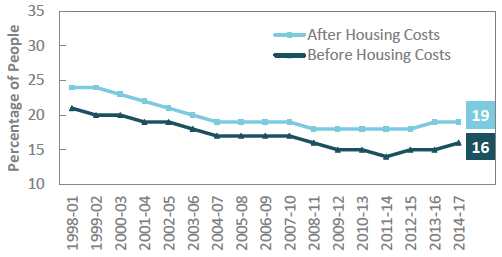
It is estimated that 16% of Scotland’s population, or 860,000 people each year, were living in relative poverty before housing costs in 2014-17. This compares to 15% in the previous period. After housing costs, 19% of Scotland’s population, or 1 million people each year, were living in poverty in 2014-17, the same as in 2013-16.
Relative poverty is a measure of whether the income of the poorest households are keeping pace with middle income households across the UK.
Poverty rates before housing costs in Scotland have been falling since the late nineties, but recent years’ data suggest a slow increase since the recession. After housing costs, relative poverty rates have been rising since the all-time low in 2011-14.
Ch14. Absolute poverty rate for all individuals
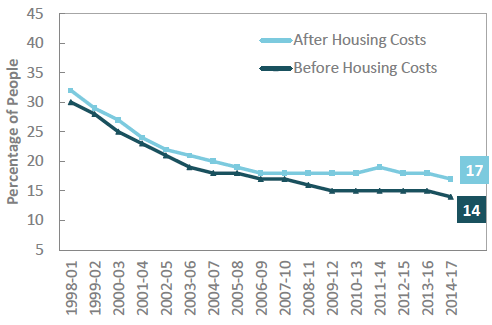
It is estimated that 14% of Scotland’s population, or 750,000 people each year, were living in absolute poverty before housing costs in 2014-17. This is roughly the same as in the previous period. Absolute poverty rates have stagnated over the last nine years following a decline until 2009-12.
After housing costs, 17% of Scotland’s population, or 910,000 people each year, were in absolute poverty. The trend is similar to the the before housing costs measure, although the stagnation happened sooner.
Absolute poverty is a measure of whether the incomes of the poorest households are keeping pace with inflation, and is based on the poverty threshold in 2010/11. The gap between before and after housing costs measure had widened in recent years, and remained steady in 2014-17.
Child poverty: relative poverty rising, absolute poverty broadly stable
Ch15. Relative poverty rate for children
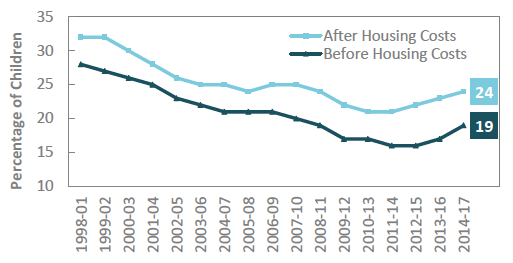
It is estimated that 19% of children, or 180,000 children each year, were in relative poverty before housing costs in 2014-17. This compares to 17% in the previous three-year period.
After housing costs, it is estimated that 24% of children, or 230,000 children each year, were in relative poverty.
Child poverty rates had been falling for many years, but have started to rise again since 2011-14.
Ch16. Absolute poverty rate for children
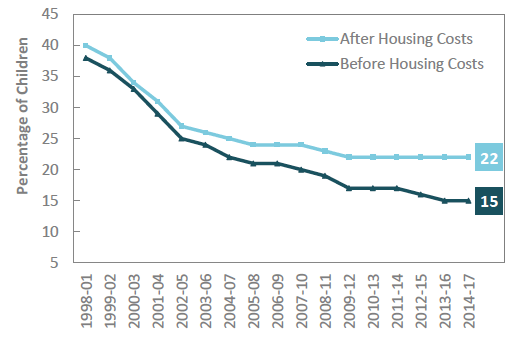
Absolute child poverty before housing costs remained at 15%, or 150,000 children each year, after a long slow decrease.
After housing costs, absolute child poverty is stagnating at 22%, or 210,000 children each year, the same as in the previous years.
As a result of the differing trends, the gap between absolute poverty before and after housing costs has widened in recent years.
The Child Poverty (Scotland) Act 2017 requires us to report annually on a number of child poverty measures. The latest single year figures can be found in a separate update here: http://www.gov.scot/Topics/Statistics/Browse/Social-Welfare/IncomePoverty
Children in combined material deprivation and low income broadly stable; children in in-work poverty rising
Ch17. Children in combined material deprivation and low income

It is estimated that 10% of children, or 100,000 children each year, were living in combined low income before housing costs ( BHC) and material deprivation in 2014-17, compared to 11% in 2013-16. After housing costs ( AHC), this was 12% of children, or 110,000 children each year, compared to 13% in 2013-16.
Combined low income and child material deprivation is an additional way of measuring living standards and refers to the inability of households to afford basic goods and activities that are seen as necessities in society.
More detail on this can be found in the Annex .
Due to a change in the methodology, it is not possible to compare the most recent years with years before 2010-13. Dashed lines in the chart indicate data collected before the change.
Ch18. In-work poverty for children
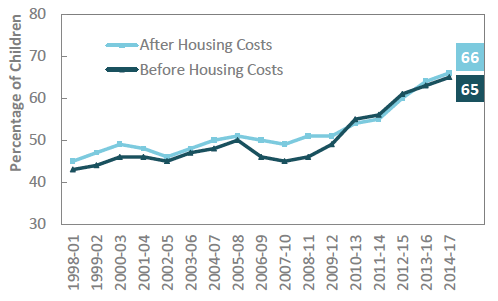
It is estimated that in 2014-17, 65% of children in relative poverty before housing costs, or 120,000 children each year, were living in working households, compared to 63% in the previous period. After housing costs, 66% of children in poverty were living in working households, compared to 64% in the previous period.
While the year-on-year change may not be statistically significant, recent years show a clear upward trend and the highest levels since reporting began.
The terms ‘working’ and ‘in-work poverty’ here refer to paid employment only. In-work poverty refers to people living in households where at least one member of the household is in either full or part-time paid work, but where the household income is below the relative poverty threshold.
Working-age adults in poverty: relative and absolute poverty broadly stable
Ch19. Relative poverty rate for working-age adults
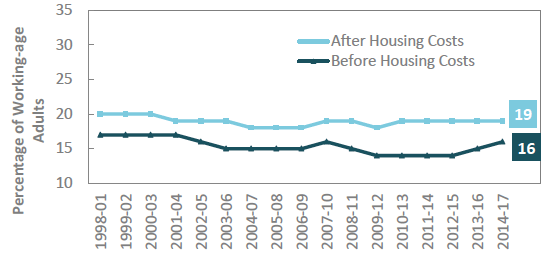
Relative poverty for working-age adults has been broadly stable since reporting began. Relative poverty in 2014-17 was estimated to be 16% before housing costs, and 19% after housing costs.
In 2014-17, there were 510,000 working-age adults in poverty before housing costs, and 630,000 after housing costs.
Working-age adults are defined as all adults up to the state pension age.Prior to April 2010, women reached the state pension age at 60. Between 2010 and 2016, the state pension age for women increased to 63, and it will subsequently increase to 65 by November 2018. At this point the state pension age for women and men will be the same.
Ch20. Absolute poverty rate for working-age adults

Absolute poverty for working-age adults has remained stable for the last ten years. In 2014-17, 14% of working-age adults were in absolute poverty before housing costs, and 18% after housing costs.
This means that there were 450,000 working-age adults each year in absolute poverty before housing costs, and 580,000 after housing costs.
Working-age adults are considered to be in poverty when they live in a household in poverty.
Poverty is measured at the household level. If the household income is below the poverty threshold, all people within the household are in poverty.
Working-age adults in poverty: in-work poverty rising
Ch21. In-work poverty for working-age adults
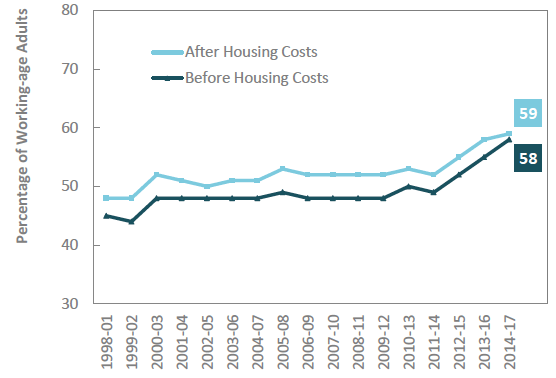
In 2014-17, 58% of working-age adults in relative poverty before housing costs were living in working households. After housing costs, this was 59% of working-age adults.
In-work poverty for working-age adults has continuously increased since 2011-14, and both, before and after housing costs measures were at an all time high in 2014-17 since reporting began.
The terms ‘working’ and ‘in-work poverty’ here refer to paid employment only. In-work poverty refers to people living in households where at least one member of the household is in either full or part-time paid work, but where the household income is below the relative poverty threshold.
Pensioners in poverty: relative and absolute poverty broadly stable
Ch22. Relative poverty rate for pensioners
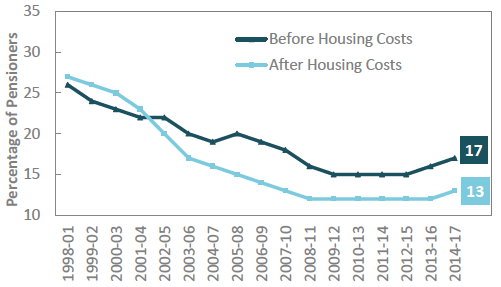
Relative poverty before housing costs for pensioners was 17% in 2014-17, or 170,000 pensioners each year. While this appears higher than in the two previous three-year periods, these changes are not statistically significant, and more data points will be needed to confirm whether it represents a long-term trend.
After housing costs, 13% of pensioners, 140,000 pensioners each year, were in relative poverty in 2014-17, which has been broadly stable since 2008-11.
The majority of pensioners own their home. Examining pensioners’ income after deducting housing costs allows for more meaningful comparisons of income between working-age adults and pensioners, or for pensioners over time.
Ch23. Absolute poverty rate for pensioners

Absolute poverty before housing costs for pensioners was 14%, or 140,000 pensioners each year, in 2014-17. After housing costs, it was 11%, or 120,000 pensioners each year.
Absolute poverty remained broadly stable since 2008-11 following a continuous decrease since reporting began.
Pensioners are defined as all those adults above state pension age. State pension age for men is 65, state pension age for women has been increasing since 2010 and will be the same as for men by November 2018.
Pensioners in material deprivation broadly stable
Ch24. Pensioners in material deprivation
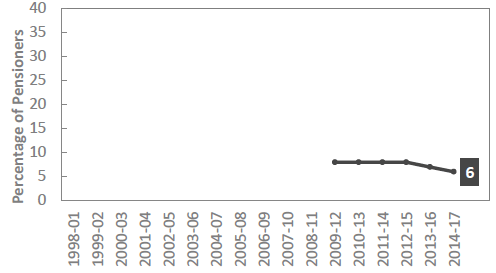
The figures show a fall in pensioner material deprivation over the last two three-year periods, but more years of data will be required to determine whether this represents a sustained change in trend.
Pensioner material deprivation is different to other measures of poverty, including the child low income and material deprivation measure, in that is not associated with an income threshold. It captures issues such as whether poor health, disability and social isolation prevent access to goods and services, rather than solely low income. More information about pensioner material deprivation can be found in the Annex .
Pensioner material deprivation is included for those aged 65 and over only and therefore is not the same population as relative and absolute poverty measures.
Contact
There is a problem
Thanks for your feedback